 At a glance
At a glanceExpert's Rating
Pros
- Robust build quality
- Attractive OLED touchscreen
- Good CPU and integrated GPU performance
- Outstanding battery life
Cons
- Design is dull
- Keyboard isn’t memorable
- Mediocre connectivity
Our Verdict
AMD’s Ryzen 7 8840HS powers the new Zenbook 14 OLED to strong benchmark results and long battery life.
AMD’s Ryzen mobile chips are increasingly competitive with Intel’s Core mobile lineup, and in recent years, AMD has taken a lead in some areas, such as battery life. The new Ryzen 7 8840HS is one of AMD’s best mid-range mobile processors yet, and it gives the Zenbook 14 OLED the edge it needs to stand out from Intel-powered competitors.
Looking for more options? Check out PCWorld’s roundup of the best laptops.
Asus Zenbook 14 OLED: Specs and features
The laptop’s headline feature is certainly the AMD Ryzen 7 8840HS processor. This is a new chip from AMD, and it’ll be interesting to see how it performs relative to older AMD chips, as well as Intel’s new Core Ultra 7 series.
- CPU: AMD Ryzen 7 8840HS
- Memory: 16GB LPDDR5x
- Graphics/GPU: AMD Radeon integrated
- Display: 1920×1200 OLED 60Hz touchscreen
- Storage: 512GB PCIe 4.0 NVMe solid state drive
- Webcam: 1080p camera with IR sensor for Windows Hello, physical privacy shutter
- Connectivity: 1x USB-C 4 Gen 3 with DIsplayPort and Power Delivery, 1x USB-C 3.2 Gen 2 with DisplayPort and Power Delivery, 1x USB-A 3.2 Gen , 1x HDMI 2.1, 1x 3.5mm combo audio jack
- Networking: Wi-Fi 6E, Bluetooth 5.3
- Biometrics: Windows Hello facial recognition
- Battery capacity: 75 watt-hours
- Dimensions: 12.3 x 8.67 x .59 inches
- Weight: 2.82 pounds
- MSRP: $849.99
The laptop otherwise embraces typical budget to mid-range specifications, including 16GB of memory, 512GB of solid-state storage, and a 1920×1200 OLED touchscreen. Asus prices their Zenbook 14 OLED at the retail MSRP of approximately $850, which is definitely a reasonable price for the hardware.
Asus Zenbook 14 OLED: Design and build quality
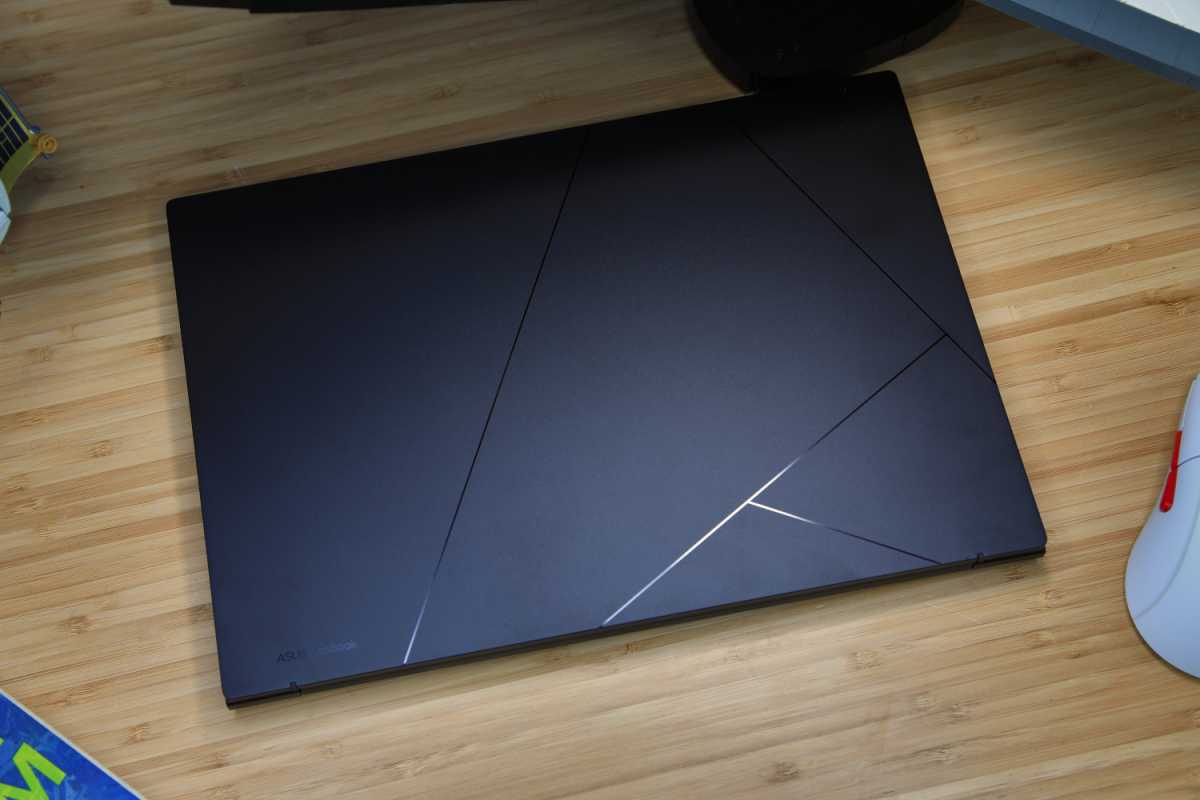
IDG / Matthew Smith
The Asus Zenbook 14 OLED, much like its predecessors, is a black slate adorned only with subtle etchings across the display lid. I always grumble about this because I remember when the Zenbook featured a stunning concentric circle design that stood out from the crowd. The current Zenbook 14 OLED’s design is inoffensive, but shoppers craving a more luxurious look should consider the Lenovo Slim 7 14.
It’s a functional design, at least. The Zenbook measures just a hair over 12 inches wide and less than nine inches deep, as well as under 0.6 inches thick. It’s also light at only 2.82 pounds. These are excellent numbers. It’s just a tenth of a pound heavier than the MacBook Air M1 13 or Dell XPS 13, and lighter than the Lenovo Slim 7 14 or Dell Inspiron 14 Plus.
Surprisingly, the Zenbook’s lightweight design doesn’t compromise build quality. The chassis allows minimal flex and feels solid when handled roughly. A wide display hinge, which is nearly as wide as the laptop itself, provides good tension, yet it’s still possible to open the laptop with a single finger. This is great to see in any laptop, but especially appreciated in a budget-friendly device.
Asus Zenbook 14 OLED: Keyboard, trackpad
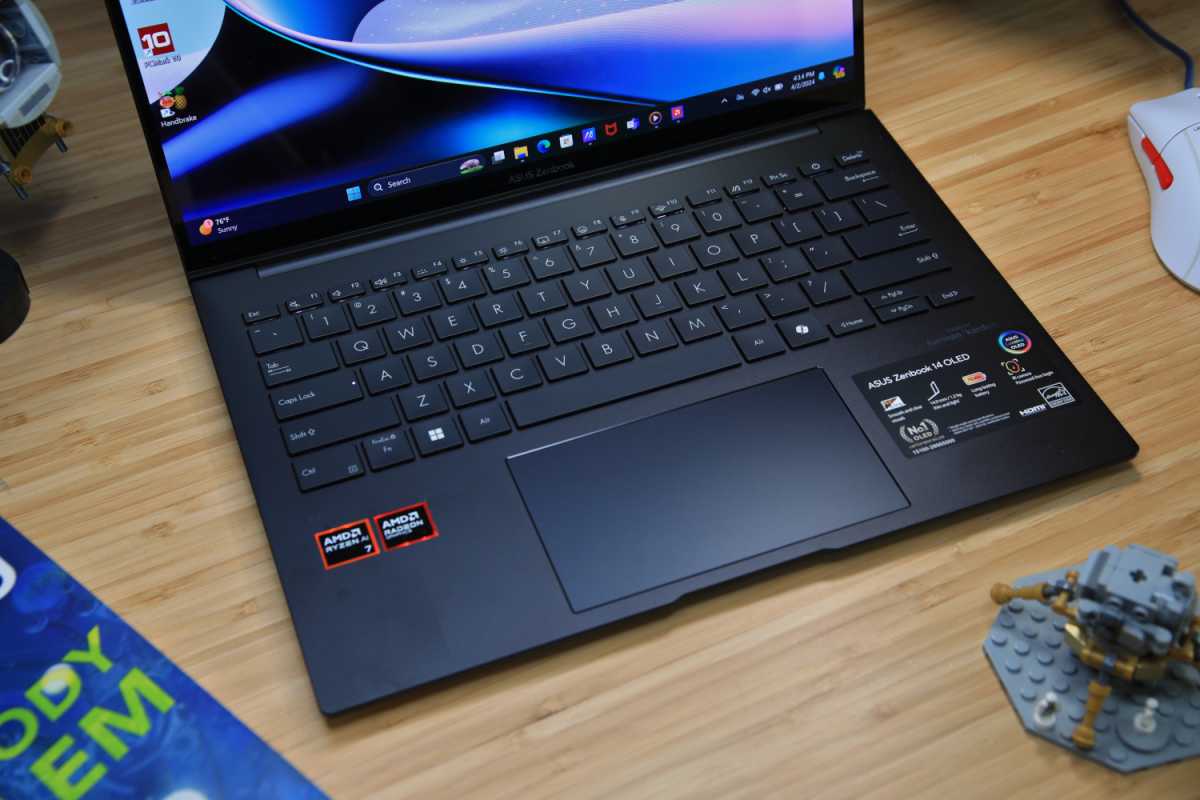
IDG / Matthew Smith
I was pleased, though not overjoyed, by the Asus Zenbook 14 OLED’s keyboard. Though some keys are slightly undersized, such as the backspace key, the layout is otherwise spacious and more accommodating than most 14-inch laptops. There’s a good amount of space on the palm rest as well, so wrist cramps are unlikely.
Key feel is acceptable. There is a reasonable amount of travel and crisp key activation, but the bottoming action is abrupt. It’s totally usable and comparable to many laptops but some similarly priced competitors, like the Lenovo Slim 7 14, have a slight edge. A white LED keyboard backlight is included and serves its purpose, providing several brightness levels with none being too dim or overly bright.
The touchpad measures about five inches wide and three inches deep. That’s plenty of space for mouse navigation and generally great for Windows multitasking gestures, with one exception. I would like to see a little bit more depth, as three inches is barely enough for using a two-finger gesture to scroll through a web page or document. There’s still a few quarters of an inch of space above and below the touchpad that Asus might manage to harness in future versions.
Asus Zenbook 14 OLED: Display, audio
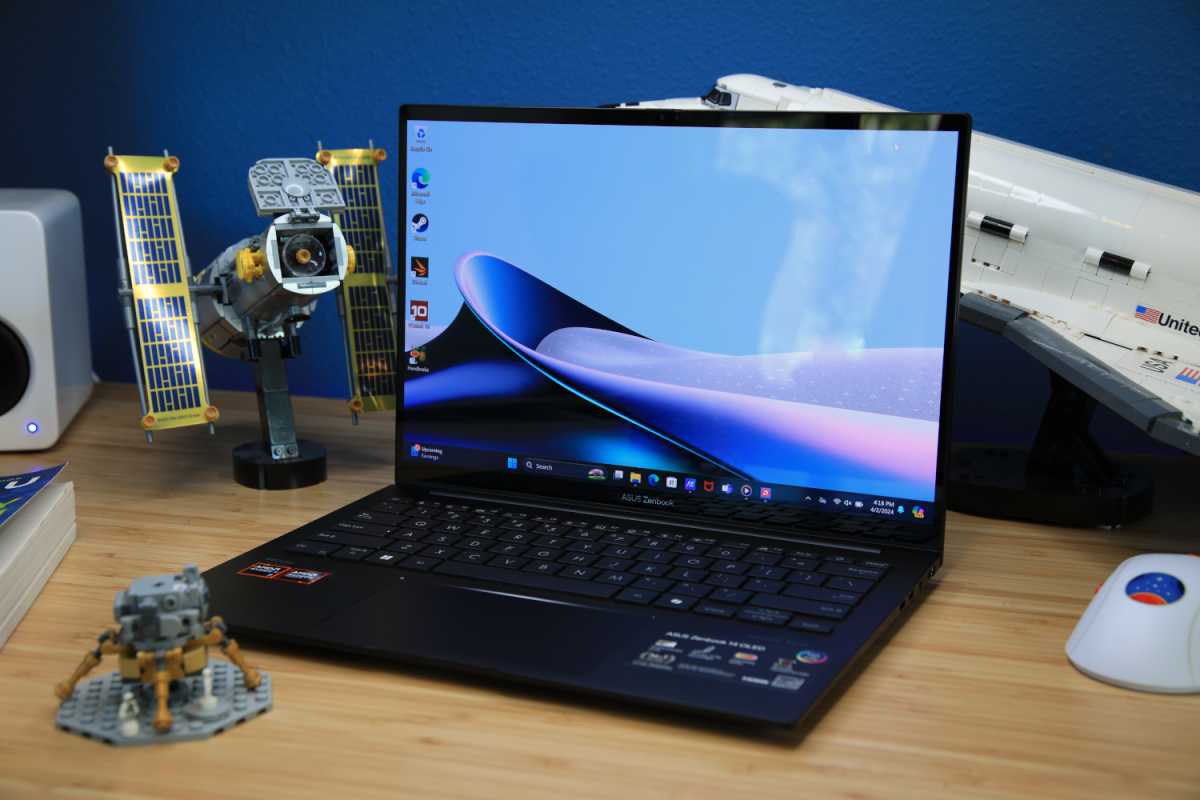
IDG / Matthew Smith
Asus equips the Zenbook 14 OLED with a 1920×1200 resolution OLED touchscreen with a maximum refresh rate of 60 Hz.
This is an entry-level OLED display, and its resolution is lower than the 2880×1800 displays that are common in many more expensive laptops. However, it still delivers the perks that would be expected from an OLED display, including an excellent contrast ratio and vivid colors. Movies and games look realistic and vibrant.
I appreciate that the display is a touchscreen, as well. This isn’t true of all competitive laptops, as some brands choose to save the touchscreen for 2-in-1 devices. I always find touch a nice option when using apps that are optimized for it, and it’s good to see it included in a budget laptop.
Though bright enough, the OLED display can be difficult to use in a bright room or outdoors, a problem not helped by the highly reflective display coat. HDR is supported and works reasonably well for a laptop but, as mentioned, the display’s maximum brightness isn’t up for delivering a truly brilliant HDR picture. To be fair, this is also true of similarly priced competitors.
Audio performance is a pleasant surprise. The laptop has downward-facing speakers with Harman Kardon branding, and they provide a great experience with a high maximum volume and a decent amount of bass when required. The sound can become a bit muddy when listening to complex music at maximum volume, but it’s an enjoyable experience overall, and owners with less critical ears won’t hear a reason to use external speakers or a headset.
Asus Zenbook 14 OLED: Webcam, microphone, biometrics
A 1080p webcam is stuffed in the Asus Zenbook 14 OLED’s top bezel. It provides crisp video with good color reproduction with balanced exposure. I don’t think the webcam’s quality stands out in 2024, as most laptops have now moved to 1080p webcams as well, but it remains excellent for video calls and other less demanding video recording needs. The laptop also includes several AI-powered features including background blur, automatic framing, and eye contact correction.
Asus provides a physical privacy shutter that slides over the camera and completely blocks it. The shutter is bright red, so it’s easy to tell when it’s activated (or not). The shutter does not deactivate the microphone.
The laptop’s microphone array captures audio with clear, crisp reproduction, and it easily picked up my voice even when I spoke softly. AI-powered noise cancellation is included and can remove most repetitive background noise. The laptop also includes several noise canceling modes for different situations: a single presenter, multiple presenters, and a “360-degree” mode for capturing all sounds around the laptop. These modes significantly changed how the microphone performed, so it’s important to use the right mode for the job.
Biometric login is supported through Windows Hello facial recognition. It works well, as usual, with fast and reliable login once the feature is set up. However, the Zenbook lacks the automatic human presence detection feature found on some alternatives, like the Lenovo Slim 7 14. That laptop can automatically detect when you approach the laptop and then activate Windows Hello for seamless, zero-touch login.
Asus Zenbook 14 OLED: Connectivity

IDG / Matthew Smith
The Asus Zenbook 14 OLED’s connectivity is a bit slim but covers all the bases. It has one USB-C 4.0 port and one USB-C 3.2 port; both of these support DisplayPort Alternate Mode and power delivery. That means both can be connected to an external monitor or be used to charge the laptop.
These ports are complemented by one USB 3.2 Gen 1 port for connecting older wired devices. The laptop also has a single HDMI 2.1 port and a 3.5 mm combo audio jack. I would have liked to see an additional USB port, and there’s certainly room on the laptop for it. Ethernet is absent, as well, so wired internet isn’t an option without an adapter.
The wireless connectivity spans Wi-Fi 6E and Bluetooth 5.3. I would like to see Wi-Fi 7 supported since it’s the most recent standard, but it’s not common among budget laptops. Wi-Fi 6E will be adequate for many years in any case, as most people have yet to upgrade their routers to that older standard. I also found the Wi-Fi to be speedy and reliable as it performed well, even in my detached office, which is several walls and over 50 feet away from my router.
Asus Zenbook 14 OLED: Performance
The Zenbook 14 OLED’s performance is noteworthy due to its AMD Ryzen 7 8840HS processor. This new chip from AMD features eight cores and 16 threads, and is manufactured using TSMC’s relatively new 4-nanometer process. The processor also integrates AMD Radeon RX 780M graphics with 12 compute units, which is the most capable version of Radeon integrated graphics available today.
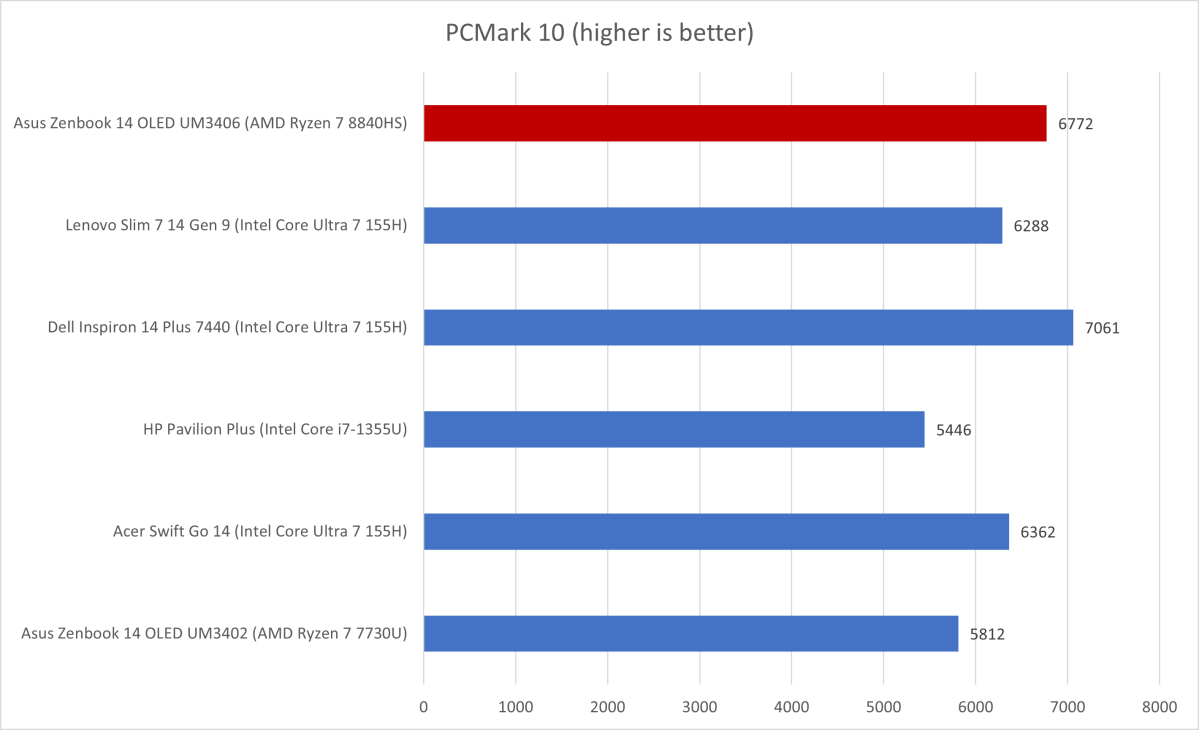
IDG / Matthew Smith
The Zenbook gets off to an excellent start in PCMark 10 with a score of 6,772. That is higher than most comparable laptops, except for the Dell Inspiron 14 7440, which squeezes out a win by a margin of a few hundred points. Asus’ victories over the Lenovo Slim 7 14 and Acer Swift Go 14 are notable since they are direct, similarly priced competitors.
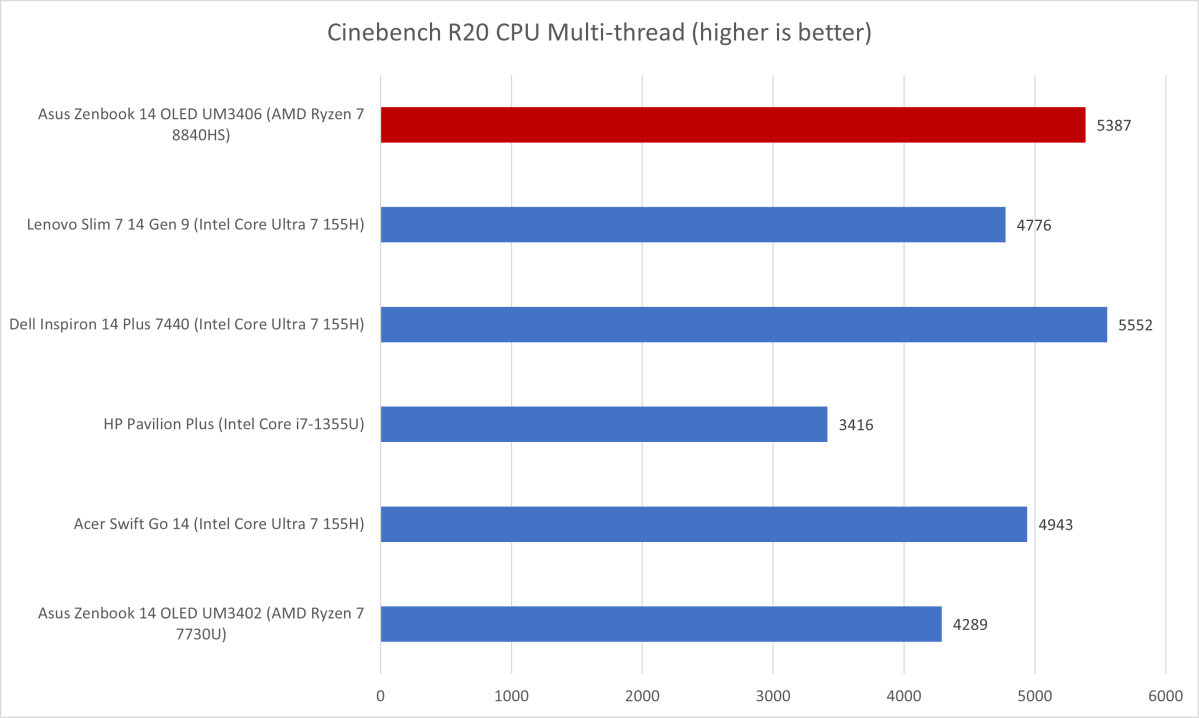
IDG / Matthew Smith
Cinebench R20, which is a short-duration, heavily multithreaded CPU benchmark, produces a result similar to PCMark 10. Once again, the Zenbook is a tad behind the Dell Inspiron 14 Plus, but it defeats other recently tested laptops with an Intel Core Ultra 7 155H processor. The new Zenbook enjoys a significant improvement over the older Ryzen 7 7730U, which we tested in last year’s Zenbook 14 OLED.

IDG / Matthew Smith
Handbrake shakes up the rankings a bit. This is a long, duration, heavily multi threaded CPU benchmark, so it provides more room for a laptops cooling solution to better define it’s performance as many laptops will be encountering thermal limits in this test. Still, the Zenbook result is quite respectable and lands in the middle of recently tested budget and mid-range laptops.

IDG / Matthew Smith
Next up is 3DMark Time Spy, which we use to test laptops with integrated graphics. The new Zenbook posts a healthy, yet mediocre result of 3,160. On the plus side, this is quite a strong score for integrated graphics, and it’s a huge upgrade over the prior AMD Ryzen-powered Zenbook 14 OLED. However, this result does land a little bit shy of Intel’s Arc integrated graphics. The difference isn’t enough to come across in real-world gameplay, but it’s there.
The Zenbook 14 OLED is not a gaming laptop, and it won’t perform well in cutting-edge AAA games that target current-generation game consoles like PlayStation 5 and Xbox Series X. However, it can handle most games from the prior console generation, albeit in some cases at low to medium settings.
It’s clear AMD has a winner on its hands with the Ryzen 7 8840HS, and that works in the Zenbook’s favor. Its performance matches or slightly exceeds that of laptops equipped with Intel’s Core Ultra 7 155H, which is popular in this price bracket. I also noticed that the Zenbook was quiet, with the fans only becoming noticeable during the most demanding benchmarks. It’s a great choice for anyone who wants a reasonably quick yet affordable machine.
Asus Zenbook 14 OLED: Battery life
A 75 watt-hour battery provides the Zenbook 14 OLED with its juice when away from a power socket. That’s not an unusually large battery for a 14-inch laptop, but it’s bigger than average, as most competitors have a battery with around 65 watt-hours. The large battery, alongside the power-efficient AMD Ryzen processor, results in excellent battery life.

IDG / Matthew Smith
I saw over 16 hours of battery life in our standard battery test, which loops a 4K file of the short film Tears of Steel. That result is well ahead of many competitors and in some cases about 50 percent better than the results recorded from alternatives, such as the Acer Swift Go 14 and Lenovo Slim 7 14.
Real-world battery life was similarly excellent in my day-to-day experience. Using the laptop constantly for my usual daily workflow, which involves plenty of writing, some web browsing, and a bit of photo editing, drains roughly 15 percent of the battery every two hours. I typically use a laptop for half my workday, so I only had to charge the laptop once every three days.
It’s important to note the battery could, in theory, be drained much more quickly in a heavy and sustained workload (like 3D gaming or encoding a lengthy video), which is true of all modern laptops. But the battery life is impressive in typical use.
Asus Zenbook 14 OLED: Conclusion
The Asus Zenbook 14 OLED UM3406 is an exceptional budget laptop. Though it’s not much to look at, it provides great performance across a wide variety of benchmarks, long battery life, solid build quality, an excellent OLED screen, strong speakers, and a quality webcam. Even the laptop’s weaknesses, such as its keyboard and connectivity, are average for the price and competitive with alternatives. This is not a performance or gaming laptop, so it has its limits—but if you’re looking for an excellent all-around Windows laptop at a respectable price, it’s hard to beat.


